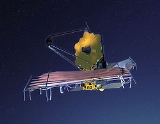
James Webb Space Telescope
Overview
Infrared
Infrared light is electromagnetic radiation with a wavelength longer than that of visible light, measured from the nominal edge of visible red light at 0.74 micrometres , and extending conventionally to 300 µm...
. The main technical features are a large and very cold 6.5 meter diameter mirror, an observing position far from Earth, orbiting the Earth-Sun point, and four specialized instruments. The combination of these features will give JWST unprecedented resolution and sensitivity from long-wavelength visible to the mid-infrared, enabling its two main scientific goals — studying the birth and evolution of galaxies, and the formation of stars and planets.
Formally planned since around 1996, JWST is a formal successor to the Hubble Space Telescope
Hubble Space Telescope
The Hubble Space Telescope is a space telescope that was carried into orbit by a Space Shuttle in 1990 and remains in operation. A 2.4 meter aperture telescope in low Earth orbit, Hubble's four main instruments observe in the near ultraviolet, visible, and near infrared...
and the Spitzer Space Telescope
Spitzer Space Telescope
The Spitzer Space Telescope , formerly the Space Infrared Telescope Facility is an infrared space observatory launched in 2003...
.
Unanswered Questions
Discussions

